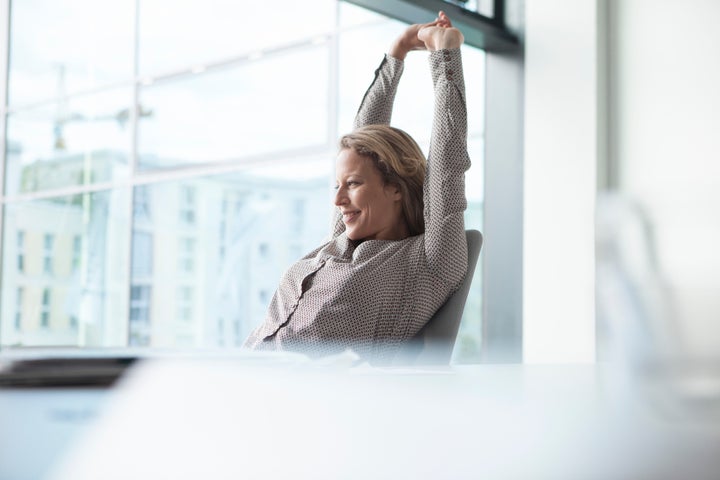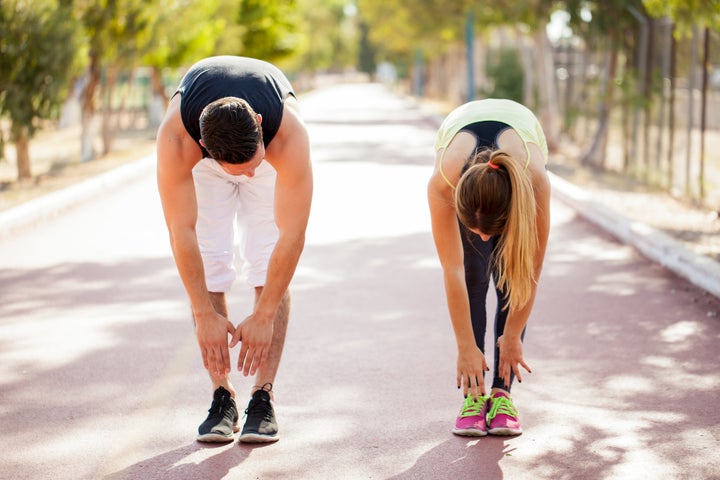We all know that aches and pains aren’t necessarily the result of an injury. Sometimes pain results from periods of inactivity like being stuck sat in the office too long, or from bursts of business, like chasing the kids around the park. Hands ache after long sessions at the keyboard. Backs get sore from sitting at a desk all day. Necks are strained from peering at a smartphone screen.
These pains can happen to anyone, at any time (although we’re finding as we get older, they are happening to us more often than ever before). They may be a part of our daily routine that we take for granted, but the pain these everyday movements can sometimes cause isn’t something we need to live with.
Here are the main reasons for your everyday pain and the small daily movements you can do to help relieve it.

Why pain happens
“Although commonly there are events that trigger an episode of pain, it is often the preceding days, weeks or months that could be contributing,” says chartered physiotherapist and GSK Human Performance Lab expert panellist, Stuart Elwell.
Elwell uses the analogy of growing trees to explain pain in the human body: when a seed doesn’t sprout, we think the soil or temperature are at fault, rather than the seed: the environment is crucial to its successful growth and, once established, the tree can survive changes in weather but still needs light and water to thrive.
“The human body is not too dissimilar, we need an environment to thrive in - our joints are designed to be mobile, the neuromuscular system we have is there to control these joints through movements.
“Evolutionarily, there hasn’t been a great deal of change to the human spine, but over the past 40 years there has been a significant increase in how much time we now spend sitting to commute, rest and in our occupations,” Elwell explains.
Keep your body moving
To counteract our sedentary tendencies, Elwell advises breaking up the day by changing postures: standing up and walking around at work, walking up stairs instead of waiting for the lift or cycling part of your commute can provide a stimulus for our bodies to thrive in a difficult environment.
He also recommends supplementing small movements with physical activities that involve changing postures, to enable our bodies to experience different stresses rather than the consistent postural stress they face regularly.

Be aware of joint stiffness
According to Elwell, stiffness in joints is very common, particularly after bouts of heavy exercise. Usually, the stiffness settles in a few days as the body adapts to the stresses that have been imposed upon it.
“Occasionally, these can accrue and the body may have limited recovery before being stressed again. Chronically, if these stresses develop beyond what the structure can withstand, tissue injury can occur, along with some increases in inflammation, and along with some of the contributing factors previously discussed, can lead to the development of pain,” Elwell says.
If you suffer from muscle or joint pain, Voltarol Pain-Eze Emulgel can help speed up recovery from post-exercise aches and pains. It provides up to three times more effective muscle and back pain relief compared to non-medicated gel.
Understand how your body compensates
Prevention is key: being aware of daily contributors to pain can go a long way in reducing incidences of issues such as low back pain, which can be caused from a sedentary lifestyle with too much sitting, or a very active one with lots of weight-bearing exercise.
The body also compensates and changes how it moves depending on the situations it faces: for example, a mid-back that has stiffened due to repeated flexed postures may lead to a low back becoming too mobile and as a consequence the next joint in the chain, the hips, stiffen.

Try these simple stretches
Hip and mid-back stiffness are becoming increasingly common, and Elwell advises a ‘prayer stretch’ or ‘child’s pose’ (on your hands and knees, sit back so the sit bones are resting on the heels and reach arms forward). This helps to encourage good hip flexion and thoracic extension.
Sally Lansdale, osteopath and clinical director of Spinex Disc Clinic, tells her patients to do cat and dog yoga poses (kneel on all fours and raise your back up like a cat, then lower like a dog). Repeat up to 10 times to loosen up your spine.
She also recommends lying on the floor with arms out to the side, then bending the right leg up and taking that leg over to the left side (then do the reverse). This stretches the lower back, and since you’re not putting weight through your spine, it allows for a much better stretch.
“Quad stretches are good to help lengthen the muscles in the front of the hips,” Lansdale explains. “We all sit down too much and need this kind of stretch to loosen up the hips.”
Stand up on one leg (holding onto something if necessary) and bend the knee of the other leg so that you can grab your foot behind your buttock. Hold like that for 30 seconds and then repeat with the other leg. Try to keep your upper body and back as straight as possible while doing this exercise.
Lansdale also recommends foot circles, for keeping ankle and foot joints mobile. Lie on your back with one leg up (knee and hip at right angles). Do 20 points and flexes and then rotate the foot outwards 20 times, then inwards 20 times. Repeat with the other leg.
Start using a foam roller
Foam rollers have become ubiquitous in fitness studios and homes everywhere – for good reason. They can help muscles from getting overly stiff and sore – and science agrees. A 2017 study in the International Journal of Sports Physical Therapy found that 90 seconds of foam rolling prior to deep squatting helped improve movement patterns, while a 2016 study in the Journal of Sport Rehabilitation discovered that foam rolling could increase range of motion and flexibility more than stretching alone. More interesting yet? A 2014 study linked foam rolling with less muscle soreness. Sign us up.
More ways to prevent pain
In addition to doing stretches and exercises, you can help prevent pain by keeping a healthy weight, avoiding sitting for too long, moving around more, warming up before a workout and not doing prolonged, repetitive movements that can lead to muscle strains.
Voltarol Pain-eze Emulgel contains diclofenac diethylammonium for pain and inflammation. Always read the label.
Stuart Elwell and Sally Lansdale do not endorse any products or brands.
Voltarol is a trademark owned by or licensed to the GSK group of companies.
The GSK group of companies does not in any way sponsor nor is otherwise affiliated with any third parties mentioned in this article.